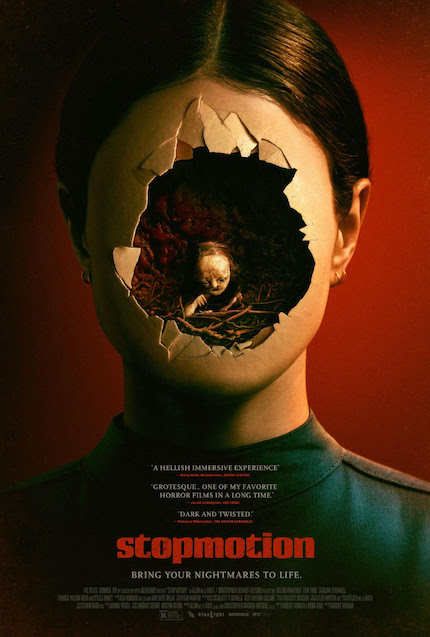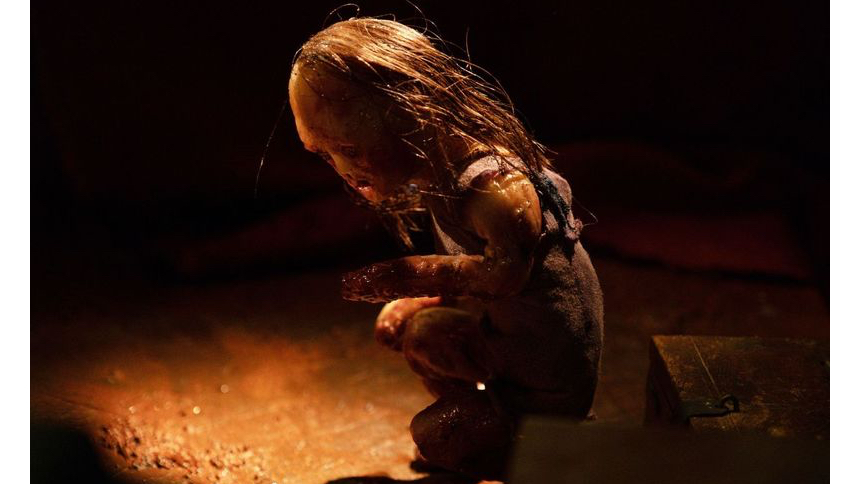STOPMOTION Review: Beautiful, Disturbing Journey Into Creation as Self-Destruction
Aisling Franciosi, Stella Gonet, and Tom York star in Robert Morgan's cross-genre horror movie.

Robert Morgan has been making some of the most fascinating and unnerving stop-motion films of all time since he began creating in the 1990s.
Now, with his first feature, he and co-writer Robin King combine live-action and stop-motion to pull audiences into the mind of a stop-motion animator who gets a little too close to her creations, something Morgan has said he experienced when making the short Bobby Yeah more than a decade ago.
The mixture of live-action and stop-motion undoubtedly made filming move along more quickly than it would have if Stopmotion were a feature-length stop-motion animated film; some of the earliest scenes in the film emphasize that stop-motion is an often grueling and tedious medium. But it’s far from a purely practical choice. The combination allows Morgan and King to tell a story about all-consuming creativity wreaking havoc on a creator.
At the start of the film, Ella (Aisling Franciosi) works and cares for her mother, an aging stop-motion filmmaker who can no longer move her creations because of the arthritis in her hands. When Ella asks if she can work with her mother on developing the story, her mother cruelly shuts her down, treating her daughter as nothing more than a pair of hands to carry out her vision. But when Ella’s mother has a stroke, Ella is freed to explore her own ideas.
Yet she doesn’t seem to have any ideas of her own. First, she tries to finish the film she was working on for her mother, but her priorities change when she meets a mysterious unnamed neighbor girl (Caoilinn Springall), who says the story is boring and offers up a new idea instead.
The girl suggests animating a girl stumbling through the woods, frightened of something unseen. Ella is unsure about the concept at first. But after she loses time and awakens to discover she’s created an effective sequence of an uncanny girl made of wax walking through a wood as something threatening skitters about in the dark, she commits to the new project.
The little girl returns and continues the story she began, proposing new ideas in segments so that Ella must return to her to continue the project. That creative hostag- holding soon becomes necessary for the girl, who wants Ella to create puppets using more and more extreme and unique materials.
She recommends combining the mortician’s wax Ella used to create the first model of the girl in the woods with a raw steak to make her look more real. Soon enough, the neighbor girl is refusing to give up the next part of the story unless Ella creates a puppet entirely from the bones, innards, and flesh of a dead fox.
The conversations, and arguments, between Ella and the strange girl allow the film to explore a macabre conception of authenticity in stop-motion animation. In one of their earliest conversations, the little girl asks why Ella creates stop-motion art and Ella says it’s because “it feels like you’re bringing something to life.” Arguably, everything that follows is the girl’s challenge to Ella to actually bring something to life, a challenge that consumes Ella and one that she may just rise to meet.
The film within a film is stunning. Before they even move, the figures are frightening to look at, as they appear to be decaying in front us. The little girl’s story is simple but feels almost mythic as the initially unseen threat makes itself known and grows slowly closer to the girl in the woods, and maybe to Ella.
Morgan uses sound design to emphasize Ella’s dissociation from reality and the imposition of her obsession with stop-motion onto every aspect of her reality. Voices often enter scenes from far off, blurry and distant, before the speaking characters force themselves into Ella’s perception by shouting or touching her. When she has sex with her boyfriend at one point, she moves her fingers along the joints of his back and hears the sounds of an armature (the artificial skeleton that allows stop-motion figures to move and hold).
But the bleed of her creation into her reality doesn’t stop with sounds. She begins to see figures from the story in the stop-motion film, forcing questions about whether Ella is creating the story or a character in it. Questions compound as the film goes on and make us wonder if the story is in fact something inside Ella that needs to come out, perhaps literally.
Stopmotion never answers any of the many questions it poses, yet they’re such interesting questions that posing them is satisfying enough, if not more than answering them would be. It also helps that the film delivers them so fantastically.
Morgan’s direction and Franciosi’s brilliant performance draw us into Ella’s headspace and worldview, where these questions are not just abstract considerations of an artist’s relationship to their art, but possibly questions of life and death. Lola de la Mata’s score, all scraping and dissonant clanging of classical instruments, is phenomenal and banishes the possibility of ever feeling comfortable while watching the film, even in its calmest moments.
At every level, Stopmotion is a formally and narratively thrilling feature debut from one of our greatest living animators. It’s of course a must watch for fans of animation, but it’s also a visually striking and thought-provoking horror movie about creativity that hopefully brings more attention to Morgan’s and others’ stop-motion work.
The film opens in select theaters Friday, February 23, and everywhere you rent movies March 15, via IFC Films. Visit the official site for more information.
Stopmotion
Director(s)
- Robert Morgan
Writer(s)
- Robin King
- Robert Morgan
Cast
- Aisling Franciosi
- Stella Gonet
- Tom York









